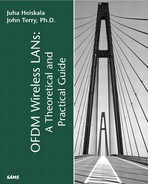Building a MAC Frame
Each MAC frame is started with a sequence of BCHs. The number of BCHs is equal to the number of sectors used by the AP. BCHs are transmitted according to the ascending sector identifier number. A single BCH is used per sector and they are transmitted periodically every two ms, except in cases where the AP is performing its own measurements related to the dynamic frequency selection (DFS) procedure [4]. In that case, some BCHs may be left out to allow the AP to perform measurements related to channel selection. BCHs are always transmitted using BPSK and coding rate 1/2.
The FCH follows directly after the BCH in the case of one sector. In the case of more than one sector, a pointer is used in the BCCH to identify the starting point of the FCH. If the FCH does not exist, the starting point in the BCCH identifies the location of the ACH. In the case the numbers of sectors field in the BCCH is set to 0, a single sectored antenna is applied and the FCH follows directly after the BCH. The pointer in the BCCH still points to the location of the FCH.
If a single sector is used, the FCH is present and has a minimum length of 36 μs. If there are not enough information elements to fill the FCH, one or more padding information elements is inserted. The minimum length of the FCH is 0 in the case where multiple sectors are used. FCH with length 0 is used for each sector where no Downlink, Uplink, or Direct Link PDU trains are allocated in FCCH.
Whenever padding information elements are to be inserted, they are allocated at the end of the IE blocks. Not more than one FCH per sector per MAC frame is transmitted. Information elements are ordered in the FCH according to the order of their occurrence in the MAC frame, i.e. with increasing start pointer values as shown in Figure 7.11. An exception is the information element for empty parts, which contain two start pointers. For this IE, the first start pointer is used for the purpose of ordering the IEs in the FCH. Not more than one RGs is used per user connections per direction per FCH. The ordering is valid individually for each sector.
The FCH is followed by an ACH (RCH feedback). The AP/CC prepares an ACH for every sector. The ACH is either part of the Broadcast PDU train (single sector AP) or part of the FCH-ACH-PDU train (multiple sector AP). The ACH uses BPSK and coding rate 1/2.
The ACH contains feedback to the RCHs of the previous frame. No explicit resource grant is needed for the ACH. An ACH that has not been received correctly, for whatever reason, leads to a behavior of an MT equal to that for an unsuccessful access attempt to an RCH and results in a new random access contention cycle.
Next in the transmission order within the MAC frame is the downlink phase, which consists of a sequence of SCHs and LCHs. The AP forms the respective PDU trains as defined and signaled in the FCCH. Same rule applies both to the direct link phase and the uplink phase. The FCCH transmitted early in the frame dictates the order and position of the SCHs and LCHs in these phases of the frame.
The last part of the frame is for RCH. At least one RCH is allocated per sector in each MAC frame. The RCHs for all sectors are clustered together; that is, the RCH phases for different sectors follow directly each other. The RCH uses BPSK with coding rate 1/2. Between RCHs there is a space for preamble and guard time. A terminal uses not more than one RCH per MAC frame.
